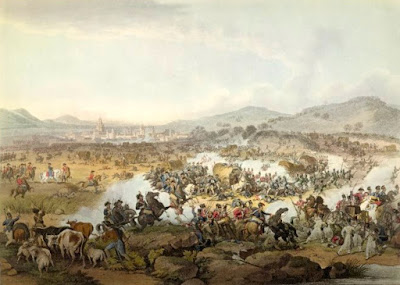 |
| The Battle of Vittoria2 - print by H Moses and FC Lewis after JM Wright published by Hassell and Rickards (1814) © The Trustees of the British Museum |
Frazer wrote a letter almost every day during his time in Wellington’s army, providing us with dramatic insights into military life during the Peninsula War. On this occasion he penned his correspondence from a site freshly contested, and no doubt still surrounded by the sights, sounds and smells that immediately followed a battle.
The confusion of victory
 |
| Reenactment at the Chalke Valley History Fair (2013) |
The action began at eight am, in front of Subijana de Morillas, and lasted till dark; the enemy having been forced back at least four leagues. I write on the spot where the action ceased, ie, at a village a league and a half in front of Vitoria, and hardly know what have been the casualties of the day; from my own observation, however, they are very considerable: to-morrow you shall know more.2
While good communication was essential to an army's performance on the battlefield, even senior officers in the early nineteenth century struggled to keep up with what was happening beyond their immediate surroundings. In this letter from Vitoria, Frazer offers little description of the battle itself, but plenty of glimpses into the detail of the aftermath.
The human cost of battle
 |
| Illustration from The Life of Field-Marshal His Grace the Duke of Wellington by WH Maxwell (1852) |
Those who came through the battle unscathed had the task of dealing with their less fortunate companions.
Frazer wrote:
At daybreak I shall perform the last sad offices to George Thelusson, who was killed in an unsuccessful charge of cavalry at the entrance of this village. His head was split with a sabre cut, and he received a stab just above the heart. I shall write to Lord Rendlesham on the melancholy subject.2
The following day Frazer oversaw the burial of “poor George Thelusson”, taking from his body his watch, ring and locket, which he implied would be passed on to the family.
 |
| Reenactment at the Chalke Valley History Fair (2013) |
I had an opportunity of solacing the agonies, and probably the last moments, of the French general of division, Sarrut, whom I helped out of the road, and laid against a bank, under charge of Bombardier Smith.
I got the poor general some brandy, and sent him a surgeon. He said he was grateful, but dying. He was sadly wounded with case shot.The action being just over I know no particulars, nor what friends may be lost. I have great reason to be thankful, having escaped unhurt. My mare was shot through the neck early in the day. We have taken many guns. I know not how many, nor how many thousand prisoners; tomorrow at daybreak will tell us all.2
More than 5,000 troops under Wellington’s command were casualties in the battle, compared to 8,000 for the French.
 |
| The death of Colonel Cadogan at the Battle of Vittoria from the History of the present war in Spain and Portugal by Theophilus Camden (1813) |
Living on the battlefield
We are in a house gutted: furniture strewed about, the inhabitants of course fled. The enemy behaved well. His artillery was more than usually well served. I imagine he must have lost much the greater part of it. The road was in many places blocked up with the guns, and with ammunition and other carriages. Adieu: tomorrow you shall have a connected account. All now is hurry, bustle, and the strange sensation which succeeds the active scenes of the day.2
Frazer was right that the French had lost most of their artillery. In total over 150 guns were captured by the British, comprising most of the French arsenal.
The French general, Sarrut, died, as Frazer had anticipated. The following day Frazer wrote:
NotePoor man!! I wish now I had taken his decoration of the Legion of Honour, but though I saw it, the general thanked me so warmly, and squeezed my hand with such earnestness, that I felt it would have been ungenerous to have taken the prize.2
(1) The modern spelling is Vitoria but it was sometimes spelt with two 't's in the 19th century.
(2) All quotes from The Letters of Colonel Sir Augustus Simon Frazer.
Rachel Knowles writes clean/Christian Regency era romance and historical non-fiction. She has been sharing her research on this blog since 2011. Rachel lives in the beautiful Georgian seaside town of Weymouth, Dorset, on the south coast of England, with her husband, Andrew, who wrote this post.
Find out more about Rachel's books and sign up for her newsletter here.If you have enjoyed this blog and want to encourage me and help me to keep making my research freely available, please buy me a virtual cup of coffee by clicking the button below.
Sources:
Camden, Theophilus, The History of the Present War in Spain and Portugal from its commencement to the Battle of Vittoria (1813)
Encyclopedia Britannica 1994 edition, Micropedia Vol 12, p405
Frazer, Sir Augustus Simon, The Letters of Colonel Sir Augustus Simon Frazer, KCB, written during the Peninsular and Waterloo campaigns edited by Major-General Edward Sabine (1859)
British Library images on Flicker
British Museum website


How nice to see compassion and for an enemy.
ReplyDeleteIt must have been very hard to come to terms with, after battle was done, that the men you have been fighting were just that - men - much the same as those you were fighting alongside. What a terrible thing war is.
Delete